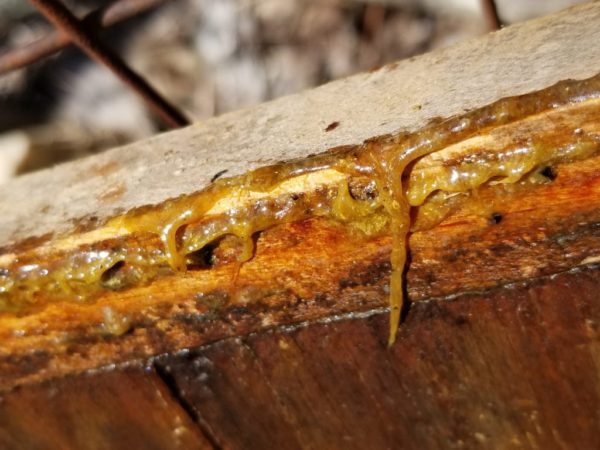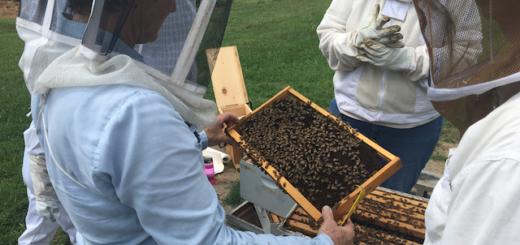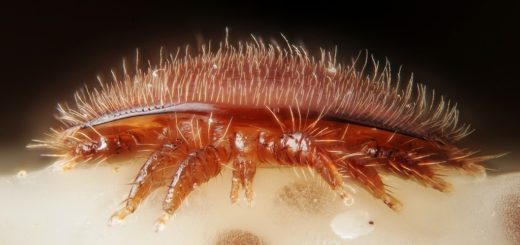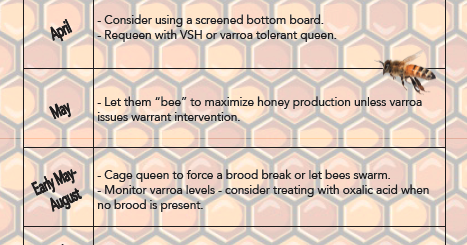A Closer Look at Propolis
Author: Dr. Lane Kreitlow |
|
 |
Propolis is the sticky resin honey bees collect from trees or other botanical sources and bring back to the hive for multiple household uses. |
Propolis is an antimicrobial, multi-purpose product used inside the hive to seal cracks, strengthen structures, repair comb, seal up any alternative entrances to the hive, and serves as a preserving or repellent agent. The wide use of propolis inside the hive is, in fact, one of the reasons why bees can stay healthy, in spite of living in a crowded space where germs can spread rapidly.
Bees collect propolis by scraping it off trees with their mandibles and packing it into their pollen baskets (corbiculae), where it is carried back to the hive. Propolis is not stored inside cells in the hive but is brought in and used as needed. It is widely used on hard surfaces inside the hive. Because propolis has antimicrobial properties, a thin layer painted over the inner surfaces serves to keep microbes in check.
Propolis is collected from a wide variety of sources, but some of the best sources include poplar, willow, alder, conifer, elm, horse chestnut, beech, and birch trees. Propolis ranges in color from dark brown or black, to reddish, and even green, depending on the source from which it was collected.
At or above room temperature, propolis is sticky, soft, and pliable, and can be easily manipulated by bees to fill gaps or varnish surfaces. Propolis becomes hard and brittle as it ages, or when the temperature drops below about 75°F.
My first experience with propolis was early in graduate school many years ago. One of the duties imposed on us “lowly” students by our lab’s technician (who shall remain anonymous) was to scrape off the propolis from the inside of the inner covers and tops of frames of all of the hives in our research apiary, using a hive tool. Here is where I learned two important lessons about propolis: 1) propolis is, indeed, very sticky and almost impossible to remove while in this state but is much easier to remove when it is old and brittle and, 2) bees do NOT like it when you scrape off propolis from their home! Not surprisingly, we frequently got stung during those exercises, and thus approached it with dread. (I always got the feeling that our “propolis duty” was more about testing our bee fortitude than anything else.) But I digress.
Bees have many uses for propolis, including the following:
Sealant
Inside the hive, bees use propolis to seal up cracks and crevices that are smaller than “bee space”. Bee space is the amount of space needed by a bee to move around easily inside the hive. Roughly 3/8”, bees seal with propolis anything smaller than bee space. Bees typically build comb in spaces larger than bee space. You will notice this phenomenon if you ever leave a spacer or partially filled hive body on the hive too long.
Like all insects, honey bees are cold-blooded, though they have mechanisms that allow them to regulate the hive temperature. One of these behaviors is the tendency to reduce potentially deadly drafts by sealing cracks with propolis. Beekeepers should remember this during cooler weather and refrain from unnecessary and too-frequent hive inspections, as every time you remove the inner cover, you are breaking the propolis seal.
In addition, left unsealed, cracks, and crevices can create rough edges, which irritate or tear the delicate wings or exoskeleton as a bee rubs up against it. A layer of propolis will smooth out surfaces to prevent this from happening.
Bee “Glue”
Propolis is commonly referred to as “bee glue”, a name of obvious appropriateness to an experienced beekeeper. Bees seal with propolis gaps formed between the inner and outer covers, hive boxes, frames and anywhere else that might make the hive drafty or let in water. The familiar “cracking” sound created when you pop off the covers of a hive occurs when you break the aforementioned propolis seal. It is nearly impossible to open a hive or remove frames without a hive tool, due to the widespread use of propolis within the hive.
Disinfecting
Propolis is well known to have antibacterial and antifungal properties. Bees commonly spread a thin layer of propolis on hard surfaces of the hive to keep down the level of microbes inside the hive. Annoying as it may be, it is best for the bees for the beekeeper to leave the propolis inside the hive, even if it makes hive inspections more difficult.
Embalming
One of the many remarkable qualities of honey bees is their keen sense of sanitation. As individual bees die, they are carried out of the hive so that their decomposing remains- and the ensuing reservoir of germs- do not remain inside the hive. In fact, one of the telltale signs of various brood diseases is the presence of dead, diseased larvae or pupae outside the front of the hive. Bees with a high level of hygienic behavior are more disease resistant because of this propensity to remove decaying and potentially infectious matter from the hive.
Sometimes, though, small animals that are too heavy for the bees to remove die inside of the hive. The highly antimicrobial properties of propolis make it an ideal substance with which to embalm dead creatures that are too large to be carried out of the hive. It is not unusual to find a mouse that has been entombed in propolis inside a hive.
Medicinal Uses by Humans
The medicinal properties of propolis have been known for centuries. The ancient Greeks, Romans, and Egyptians knew about it. Pliny the Elder knew about. Aristotle knew about it. Even Hippocrates, the father of modern medicine, is said to have used propolis to cure internal and external wounds. The first recorded human use of propolis dates back to 300 BC and continues to this day. Its use is particularly popular in herbal and natural medicine.
Advocates believe that propolis has antiseptic, antibacterial, astringent, anti-inflammatory, antioxidant, anesthetic, and possibly even anticancer properties in humans. Though scientific evidence is sparse with some of these claims, it is well established that propolis has antimicrobial properties. Propolis is included in ointments, creams, and tinctures in a variety of products used for skin problems, burns, and wound healing.
Harvesting Propolis
Propolis is usually harvested with a propolis trap, a thin, plastic sheet that is perforated with narrow slits just slightly less than-you guessed it- bee space. They look similar to queen excluders, but with smaller gaps.</p
The idea is that bees will propolize the gaps in the trap when it used in place of the inner cover. The outer cover can be propped up just a bit to allow light into the hive. Bees will readily seal the trap with propolis in order to block out the light, as well as drafts created by the holes in the trap. When the trap is full of propolis it is removed from the hive for harvesting.
For propolis that cannot be easily scraped off, the trap can be placed in a bag and frozen, and the residual propolis removed from the slits by banging it onto a hard surface. Autumn is a good time to trap and collect propolis since this is the time of year when bees seal drafts in preparation for winter.
Propolis may also be harvested without the use of a trap by simply scraping it from areas where it has been placed in the hive.
Propolis is particularly popular in the natural products industry, though the medicinal use of propolis tends to be more popular in Europe than in the United States.
To some beekeepers, propolis may be an aggravation, but it is a crucial hive product that helps bees stay healthy. Think about this the next time you have difficulty removing your frames, and it might curb your frustration. As for my fading memories of scraping propolis all of those years ago, it did indeed instill a sense of bee fortitude but even more, an unwavering appreciation for all things honey bee.






